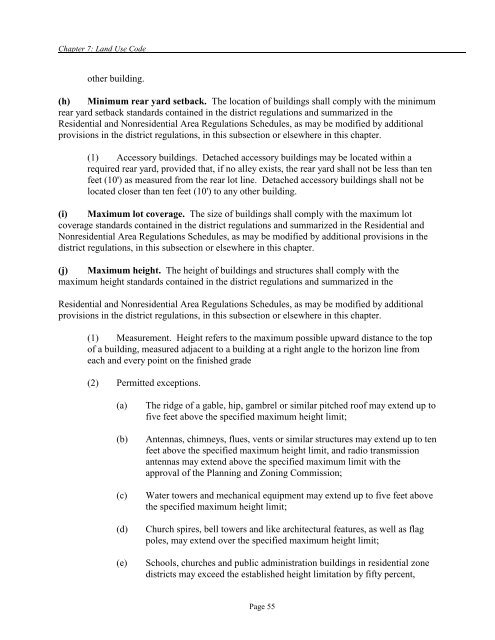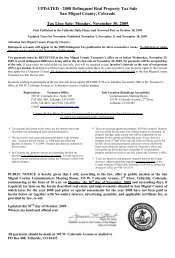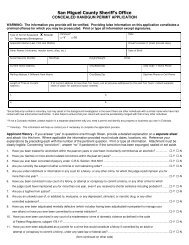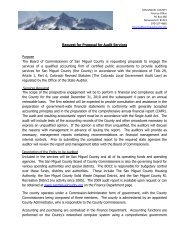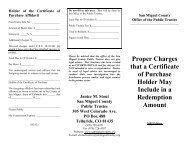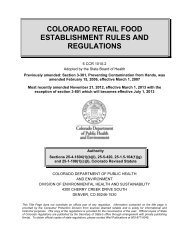Land Use Code Town of Norwood, Colorado - San Miguel County
Land Use Code Town of Norwood, Colorado - San Miguel County
Land Use Code Town of Norwood, Colorado - San Miguel County
You also want an ePaper? Increase the reach of your titles
YUMPU automatically turns print PDFs into web optimized ePapers that Google loves.
Chapter 7: <strong>Land</strong> <strong>Use</strong> <strong>Code</strong><br />
other building.<br />
(h) Minimum rear yard setback. The location <strong>of</strong> buildings shall comply with the minimum<br />
rear yard setback standards contained in the district regulations and summarized in the<br />
Residential and Nonresidential Area Regulations Schedules, as may be modified by additional<br />
provisions in the district regulations, in this subsection or elsewhere in this chapter.<br />
(1) Accessory buildings. Detached accessory buildings may be located within a<br />
required rear yard, provided that, if no alley exists, the rear yard shall not be less than ten<br />
feet (10') as measured from the rear lot line. Detached accessory buildings shall not be<br />
located closer than ten feet (10') to any other building.<br />
(i) Maximum lot coverage. The size <strong>of</strong> buildings shall comply with the maximum lot<br />
coverage standards contained in the district regulations and summarized in the Residential and<br />
Nonresidential Area Regulations Schedules, as may be modified by additional provisions in the<br />
district regulations, in this subsection or elsewhere in this chapter.<br />
(j) Maximum height. The height <strong>of</strong> buildings and structures shall comply with the<br />
maximum height standards contained in the district regulations and summarized in the<br />
Residential and Nonresidential Area Regulations Schedules, as may be modified by additional<br />
provisions in the district regulations, in this subsection or elsewhere in this chapter.<br />
(1) Measurement. Height refers to the maximum possible upward distance to the top<br />
<strong>of</strong> a building, measured adjacent to a building at a right angle to the horizon line from<br />
each and every point on the finished grade<br />
(2) Permitted exceptions.<br />
(a)<br />
(b)<br />
(c)<br />
(d)<br />
(e)<br />
The ridge <strong>of</strong> a gable, hip, gambrel or similar pitched ro<strong>of</strong> may extend up to<br />
five feet above the specified maximum height limit;<br />
Antennas, chimneys, flues, vents or similar structures may extend up to ten<br />
feet above the specified maximum height limit, and radio transmission<br />
antennas may extend above the specified maximum limit with the<br />
approval <strong>of</strong> the Planning and Zoning Commission;<br />
Water towers and mechanical equipment may extend up to five feet above<br />
the specified maximum height limit;<br />
Church spires, bell towers and like architectural features, as well as flag<br />
poles, may extend over the specified maximum height limit;<br />
Schools, churches and public administration buildings in residential zone<br />
districts may exceed the established height limitation by fifty percent,<br />
Page 55


